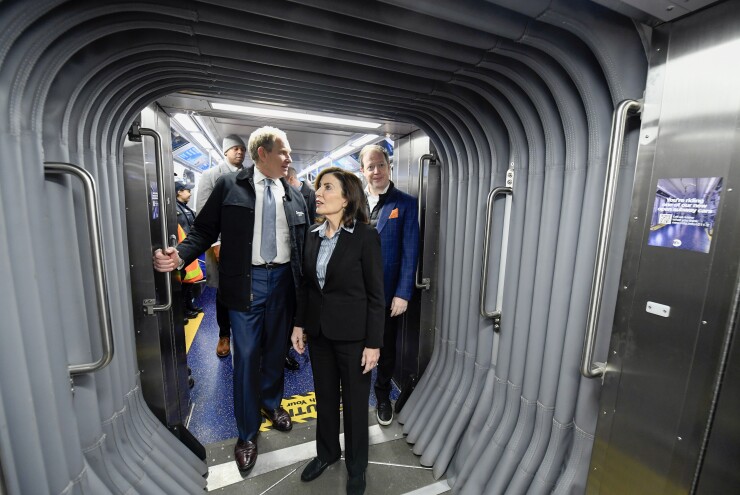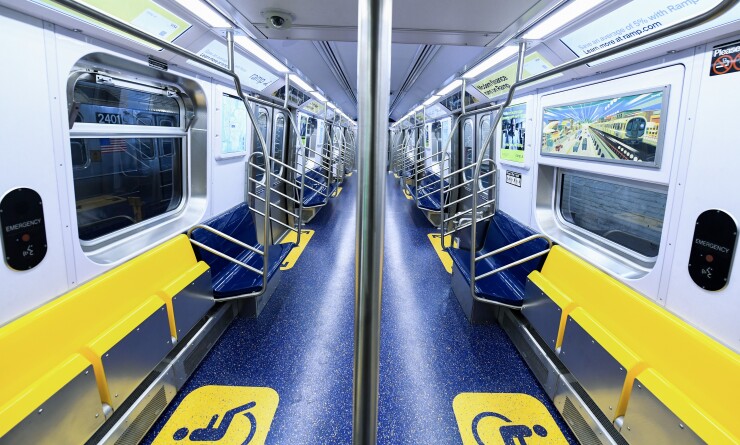Repair needs for the New York Metropolitan Transportation Authority MTA will cost at least $43 billion over the next several years, according to a new report issued by state comptroller Thomas DiNapoli.
DiNapoli said the
“The list of repairs and upgrades needed in our regional transit systems can seem endless, but funds are limited,” DiNapoli
Marc A. Hermann/N.Y. MTA
DiNapoli criticized the state-run transportation agency for failing to include projected costs associated with needed system repairs in its 2023
The comptroller’s office based its own estimate on the MTA’s 2013 data, adjusted for inflation.
The absence of costs makes it difficult to determine how much investment is needed when capital funds are limited, the comptroller’s report said.
The report also said:
- Signal problems were responsible for 25% of major incidents delaying trains in 2022 and 2023.
- About 7% of subway signals have been modernized with 24% being constructed or to be built this year and 69% still using an older system.
- The needs assessment projects the MTA will have to buy more than 3,900 subway cars over the next 20 years to replace existing cars at an estimated cost by the comptroller’s office of $15 billion.
- According to the assessment, 73% of the subway rail car maintenance building structures and 69% of the roofs at maintenance-of-way support shops are in poor or marginal condition.
- According to the assessment, 100% of the Grand Central Terminal train shed’s structural supports and roof slab, drainage system and HVAC system are in poor or marginal condition and all of the platforms that the MTA’s Long Island Rail Road is responsible for maintaining at Penn Station are in poor or marginal condition and have received minimal capital funding in recent years.
Since 2012, the MTA has sold almost $41 billion of bonds, with the most issuance occurring in 2012 when it offered $6.7 billion and the least in 2022 when it sold $378 million.
In October, Fitch Ratings upgraded the MTA’s transportation revenue bonds to A from A-minus and assigned a stable outlook to the bonds.
The upgrade “reflects a material improvement in the MTA’s fiscal outlook, which was largely driven by New York State increasing the maximum rate of the payroll mobility tax,” Fitch said. “This resulted in a substantial increase in recurring revenues for the operating budget.”
Fitch said the mobility tax increase will help the MTA’s financial standing in future years.
In September,
The MTA’s TRBs are also rated AA by Kroll Bond Rating Agency, which has a stable outlook.
TRBs are backed by a gross lien on the MTA’s operating revenues, which include fares received from the MTA’s subway and bus systems operated by New York City Transit and the Manhattan and Bronx Surface Transit Operating Authority and the commuter railroads operated by Long Island and Metro-North railroads. TRBs are also backed by a gross lien on operating subsidies from the state and the city and surplus funds from the MTA’s bridges and tunnels operations.
Historically, TRBs have been the MTA’s workhorse, but MTA has not been in the market with that credit since a $700 million sale in 2021.
It has gone to market with bonds
The MTA is a public benefit corporation of the state created in 1965. It is responsible for establishing a unified mass transportation policy for its coverage area, which includes New York City and Duchess, Nassau, Orange, Putnam, Rockland, Suffolk and Westchester counties. In addition, the MTA’s Metro-North Railroad serves Fairfield and New Haven counties in Connecticut, with
MTA operations are performed through nine different agencies, including the Triborough Bridge and Tunnel Authority. The TBTA surplus left over after paying its own bills and debt service are transferred to MTA to subsidize subway, bus and commuter rail operations in New York City and its environs.
On Thursday, the MTA rolled out its new R211T open gangway subway cars on the C line, marking progress towards increasing security camera deployment throughout the system.
“New train cars, additional security cameras and more reliable service will make the subway system even better for decades to come,” said Gov. Kathy Hochul, who led an inaugural ride with MTA leadership on the line that runs between Washington Heights and East New York.
The ride marked the first time an open gangway train has operated in the modern history of subways in the United States, according to the MTA. Open gangways are wide openings between cars without doors, allowing passengers to freely move around the train. They have
The open gangway R211Ts are part of a larger order of R211A conventional cars, funded by the Federal Transit Administration, which includes money from the Bipartisan Infrastructure Bill.
“The average age of MTA subway cars is 25 years old and our oldest subway car, the R46, is nearly 50 years old,” said MTA Chair and CEO Janno Lieber.
“As the 20-year needs assessment pointed out, the MTA needs to acquire thousands of cars, they need to be the most innovative designs and be eligible for federal funding. This pilot program will teach us if the open gangway design works for New Yorkers,” he said.
Continuous reinvestment in the system is required due to its age and the daily usage of the system, said John Hallacy, founder of John Hallacy Consulting LLC.
“Although ridership is not at peak post-Covid, the planning must be done to address the peak and allow for some growth. Some of the early new subway cars that have been tested had to be reengineered to an extent to cope with the punishing conditions of system operations,” Hallacy told The Bond Buyer.
“The real challenge is timing the onboarding of new equipment and infrastructure for when the financial side may handle the increased obligations even net of federal aid that is available,” he said.
“Over the longer haul, all of the improvements will be borne out. The pressure point is always in the early years of a major overhaul because of the intensity of the capital spending and determining what the new operational costs will be. Hopefully, the latter will be improved and will support the fiscal strength of the system,” he said.
“Bringing down the mean distance between breakdowns has always been a primary focus. New equipment will help with this data point,” Hallacy added.

Marc A. Hermann/MTA
The new subway cars are part of the MTA’s efforts to modernize its system.
The R211As have security cameras in each car, adding to the 1,000 cars that already have them. The rest of the NYC Transit fleet is scheduled to have in-car camera installations completed by next January. The in-car cameras are in addition to the 15,000 cameras that are in the stations and on the platforms.
The R211s have 58-inch-wide door openings, which are eight inches wider than the existing doors and are designed to speed up on and off boarding. The cars also have more accessible seating, detailed digital displays and brighter lighting.
“The R211A shifted the riding experience for riders with a disability, providing wider doors as well as enhanced accessible seating options,” said MTA Chief Accessibility Officer Quemuel Arroyo. “The open gangway concept goes one step further, allowing riders using a wheelchair or traveling with a stroller to for the first time in modern times be able to navigate between train cars without having to get off.”
